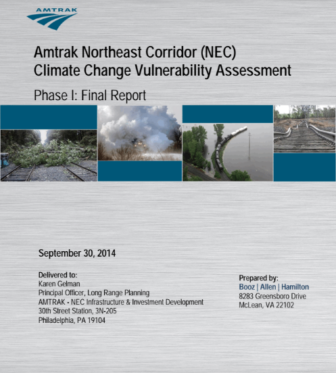What follows is a public apology. Not to you, dear reader, but to future generations.
“To my grandchildren: I’m sorry we left you with this mess. We should have done more, when we still had time.”

Image from the report on Document Cloud
The Amtrak report from late last year that Bloomberg News obtained through the U.S. Freedom of Information Act.
What am I referring to? Not the national debt. Not even global terrorism. No, this apology is about coastal flooding that threatens the Northeast Corridor’s rail lines.
I won’t even get into the debate about what’s causing sea-level rise. Whether it’s man-made or natural, it is happening and we have not been planning for its inevitable effects.
Sure, when the tides are high and the winds are from the east, we already see a little flooding along the Connecticut coastline.
“Look Dad, the beach parking lot is under water,” children would say. But the tides and winds subsided and we’d forget about it.
Aside from pretty beaches and expensive homes, what else is along Connecticut’s coast? Our railroads: Metro-North, Shore Line East and Amtrak. According to a long hidden report, those tracks, and the trains that run on them, are being threatened by sea level rise.
Bloomberg recently wrote about a three-year study — Amtrak NEC Climate Change Vulnerability Assessment — that was finished in 2017, but never released to the public. Bloomberg used a Freedom of Information request to obtain a redacted portion of the study, and its findings are frightening.
— Web links in this article were added by Darienite.com.
The Northeast Corridor of Amtrak runs 457 miles from Washington to Boston and carries 12 million passengers a year on 2,200 daily trains. Those tracks serve Amtrak’s inter-city trains and also many commuter rail lines, like Metro-North and Shore Line East.

Part of a table from page 12 of the Amtrak Northeast Corridor Climate Change Vulnerability Assessment report.
The rising sea level is already lapping at its edge, where in some areas those tracks are just feet from the ocean. By 2050, the water may be two feet higher.
When it was originally built in the 19th century, the coastline made perfect sense as a location for the railroad tracks: the coast is where the major cities were and the terrain was flat, perfect for trains. Sure, there were storms (even hurricanes) that caused short-term flooding, but nothing that was persistent. Until now.
So what can be done?
Amtrak and the Federal Railroad Administration have no plans to raise the tracks. They’re already facing $40 billion in unfunded projects just to keep the darn trains running. As for building a “wall” to keep out the sea water, even a temporary version erected before a storm would take 12 to 30 days to assemble and cost $24 million a mile.
Keeping this all in perspective, Amtrak reminds us the cities they serve along the coast are also in danger of flooding, so what are a few damp railroad tracks when your city-center looks like Venice?
What’s most concerning is that this study was suppressed by Amtrak and the FRA because, as Bloomberg wrote, “The disclosure of that information could possibly cause public confusion.”
I’m not confused, are you? Maybe enraged, but not confused. I may not be around to see these predictions come to pass, but I do feel some sense of obligation (guilt) to future generations to whom I can offer little more than an apology.
Sorry, kids. We left you with a mess. We should have done more.
____________________

Jim Cameron
Jim Cameron
Jim Cameron has been a Darien resident for more than 25 years. He is the founder of the Commuter Action Group, sits on the Merritt Parkway Conservancy board and also serves on the Darien RTM and as program director for Darien TV79. The opinions expressed in this column, republished with permission of Hearst CT Media, are only his own. You can reach him at CommuterActionGroup@gmail.com.

